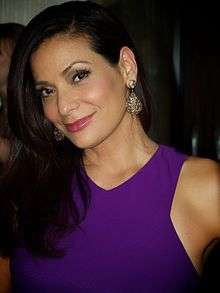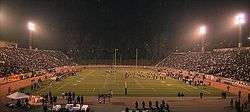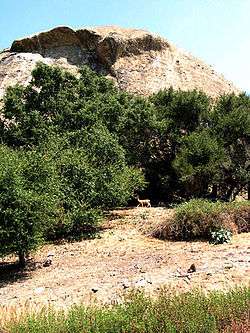Eastside Los Angeles
The Eastside of Los Angeles County, California, is a geographic region that includes the neighborhoods of Boyle Heights, El Sereno and Lincoln Heights within the city of Los Angeles and also East Los Angeles, California, an unincorporated area.[1]
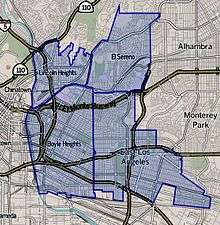
Los Angeles Times


History
East Los Angeles was founded in 1870 by John Strother Griffin (1816–1898), who was called "the father of East Los Angeles."[2] He was said to have created the first suburb of the city of Los Angeles in Lincoln Heights after he purchased 2,000 acres of ranch land for $1,000 and in 1870, with his nephew, Hancock Johnson, erected houses on the site. That land was a rancho called La Rosa de Castilla, on the east side of the Los Angeles River, taking in the deserted hills between Los Angeles and Pasadena. In late 1874 the two men offered an additional thirty-five acres, divided into 65x165-foot lots, for $150 each.[3][4] They planned the laying out of streets of the present community of East Los Angeles and gifted East Side Park (the present Lincoln Park) to the city of Los Angeles.[4][5]
Population and housing
In 2000, a total of 286,222 people lived in the 20.66 square miles of the Eastside region, amounting to 13,852 people per square mile. The neighborhood was "not especially diverse" ethnically, with a high percentage of Latino people. The ethnic breakdown was Latino, 91.2%; Asian, 5.2%, white, 2.3%; black, 0.7% and other, 0.6%. Just 5.1% of residents aged 25 and older had a four-year college degree. More than two-thirds (66.8%) of the inhabitants lived in shared housing, and 33.2% were homeowners.[1]
Communities
Notable places
- Latino Walk of Fame - East Los Angeles
- Mariachi Plaza - Boyle Heights
- El Mercado de Los Angeles - Boyle Heights
- Calvary Cemetery (Roman Catholic) - East Los Angeles
- Home of Peace Cemetery (Jewish) - East Los Angeles
- Evergreen Cemetery - Boyle Heights
- Chinese Cemetery of Los Angeles - East Los Angeles
- Estrada Courts Murals - Boyle Heights
- El Pino (The Pine Tree) - East Los Angeles
Notable people
- Narciso Botello (about 1813–1889) Mexican Army officer and California State Assembly member[8]
- Howard E. Dorsey, hydraulic engineering, politics[9]
- Jaime Escalante, education[10]
- Kid Frost, rap[11]
- Andy Russell, big band, swing, sang "Bésame Mucho," first bilingual (English/Spanish) crooner
- John Strother Griffin (1816–1898), surgeon, founder of East Los Angeles and a member of the Los Angeles Common Council[4]
- Hope Sandoval, singer-songwriter[12]
- Edward James Olmos, acting[13]
- Anthony Quinn, acting[14]
- will.i.am (William James Adams, Jr.), music[15]
- Constance Marie, American actress, known for her role as Angie Lopez on George Lopez (2002–07) and her role as Marcela Quintanilla (mother of Selena) in the 1997 film Selena. She currently portrays Regina Vasquez on the ABC Family drama Switched at Birth.
Contested geography

The Mapping L.A. project of the Los Angeles Times defines the Eastside as comprising Boyle Heights, El Sereno, Lincoln Heights, and East Los Angeles.[1] However, the boundaries are a matter of perennial discussion and debate among the residents of Los Angeles.[16]
The Mapping L.A. definition corresponds to the traditional boundaries, but, beginning in the early 21st century, residents of some of the rapidly gentrifying neighborhoods west of Downtown Los Angeles but on the eastern side of Central Los Angeles, such as Echo Park and Silver Lake, began to refer to their neighborhoods as part of the Eastside.[16] This debate has generated some friction, which, according to Ali Modarres, an expert on the geography of Los Angeles from the University of Washington Tacoma, is to be expected because neighborhood names are "full of meaning, nuances, history, cultural and political relationships."[16] Eric Garcetti, the mayor of Los Angeles and a fourth generation resident, is a traditionalist, stating that "true east is east of downtown."[16]
The trend led the Silver Lake Neighborhood Council to declare officially in February 2014 that Silver Lake is not part of the Eastside.[16]
The Sixth Street Viaduct, also known as the Sixth Street Bridge was demolished. Prior to the demolition, Los Angeles mayor Eric Garcetti recorded the rap song "101SlowJam", backed by musicians from Roosevelt High School, and issued it via a video on his own YouTube channel. The public service announcement video advertised the closure of parts of the 101 Freeway to accommodate the demolition of the viaduct.[17][18]
See also

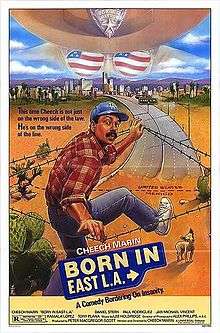
- Born in East L.A., motion picture
- Chicano, ethnic term
- East LA Classic, football game
- Blood In Blood Out, motion picture
- City Times in Los Angeles Times suburban sections
- Zoot Suit Riots, 1943
- Ten Latino neighborhoods in Los Angeles County
Bibliography
- Romo, Ricardo (1983). East Los Angeles: History of a Barrio. Austin, Texas: University of Texas Press. ISBN 0-292-72041-6.
References
- 1 2 3 "The Eastside," Mapping L.A., Los Angeles Times
- ↑ H.D. Barrows, "Memorial Sketch of Dr. John S. Griffin," Annual Publication of the Historical Society of Southern California and Pioneer Register, Los Angeles, Volume 4, Number 2, 1898
- ↑ "Street Name," EastLosAngeles.net
- 1 2 3 "Founder of Cities," Los Angeles Times, August 24, 1898, page 1
- ↑ "Griffin, John S. (John Strother), 1816–1898," Social Networks and Archival Context Project
- ↑ "Los Angeles Times Neighborhood Project". The Los Angeles Times. Retrieved 2010-04-11.
- ↑ Jennifer Delson, "A Campus Enclave That's a Study in Contrasts." Los Angeles Times, April 24, 2005
- ↑ "Death of Narciso Botello," Los Angeles Herald, November 21, 1889, page 2
- ↑ Los Angeles Public Library reference file This file was compiled in 1937 by Works Progress Administration worker Clare Wallace from an interview with Dorsey on June 23 of that year and from newspaper articles.
- ↑ Honoring a legendary teacher and his legacy
- ↑ Huey, Steve (2006). "Frost > Biography". allmusic. Retrieved 2008-12-18.
- ↑ "The Official Website of Hope Sandoval". HopeSandoval.com.
- ↑ Bethel, Kari Francisco (2002) "Edward James Olmos" pp. 155-159 In Henderson, Ashyia N. (editor) (2002) Contemporary Hispanic Biography, Volume 1 Gale, Detroit, page 156, ISBN 0-7876-6538-X
- ↑ Los Angeles County Anthony Quinn Public Library
- ↑ 'will.i.am's Aha! Moment' (April 14, 2009) Oprah.com
- 1 2 3 4 5 Esmerelda Bermudez (February 18, 2014). "East is East, but Eastside is open to debate". Los Angeles Times. Retrieved February 18, 2014.
- ↑ Pedersen, Erik (January 28, 2016). "[WATCH] 101 Freeway Closure: LA Mayor Eric Garcetti Slow-Jams Reminder". Deadline. Retrieved February 6, 2016.
- ↑ #101SlowJam on YouTube
External links
| Wikimedia Commons has media related to East Los Angeles. |
- The Eastsider LA
-
 East Los Angeles travel guide from Wikivoyage
East Los Angeles travel guide from Wikivoyage - East LA Guide
